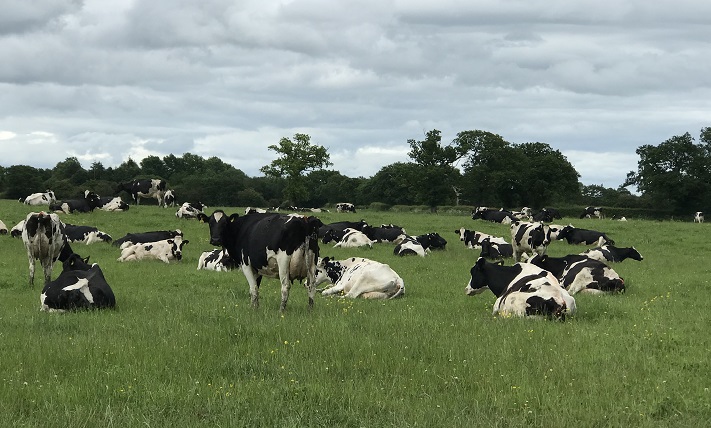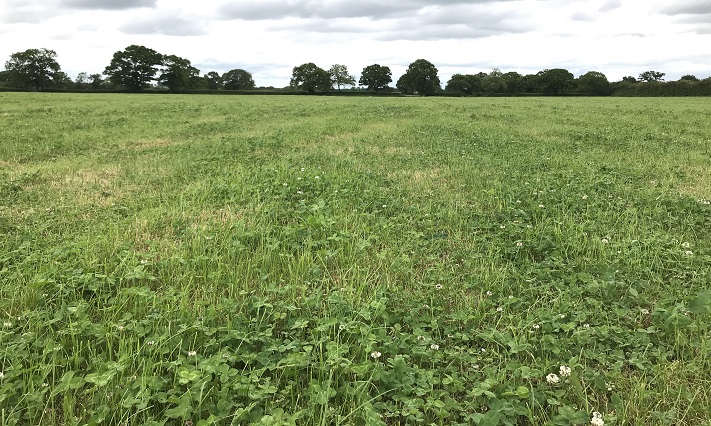Good returns from clover
Clover plays a crucial role at an organic dairy unit in Shropshire
Barry Jones and his son Sam, run 230 dairy cows on 240 hectares of heavy clay land at Tilley Park Farm near Wem in Shropshire. Fifty hectares of organic winter oats are also grown.
The herd has been organic since 2007 when Barry realised significant changes were needed to improve the profitability of the conventionally raised cows, which were producing 7,000 litres of milk each year.
“I felt we needed to become a bit more specialised. We chose to go organic and have had no regrets,” says Mr Jones. “We sell to Arla and for the past five years have been one of 60 farmers supplying milk to McDonalds. This has been very positive for us – the standards we are expected to attain are very high, but there are many benefits, such as access to technical discussion groups and specialist improvement grants.”
-and-Sam-Jones.jpeg) Barry (right) and Sam Jones
Barry (right) and Sam Jones
The Jones’ cows are Holsteins, bred for longevity and strong body traits. They calve from October to the end of June. This leaves three summer months for carrying out harvest and field work when the team do not have to worry about calving or looking after baby calves. Sexed semen is used to AI the cows and the few black and white bull calves that do arrive are sold to Meadow Quality. The current Calving Index stands at 390 days.
The cows now average 8,500 litres a year, with 4,000 litres coming from forage. They are milked twice a day and, in winter are fed a Total Mixed Ration (TMR) consisting of red clover and oat wholecrop silages, with home-milled and mixed oats and 35% protein blend. A 16% protein organic concentrate is fed in the parlour.
Seed mixtures
White clover and perennial ryegrass seeds mixtures are grown for an average of six years where the cows graze – although there are those that continue to perform well into their tenth year before being reseeded. Sam measures grass growth weekly with a platemeter and monitors the data using the AgriNet system.

 This field has good clover regrowth ten days after cutting
This field has good clover regrowth ten days after cuttingOut of a total seed rate of 13kg/ha, 1.75kg is made up of a blend of high performing red clovers with 1.75kg of the white clover Brianna. This is the largest leaved white clover on the Recommended Grass and Clover List and is ideal for use on cutting leys. Its stoloniferous, creeping growth habit means it persists much longer than red clover – which grows upwards from a single crown and will last up to four years.
The silage fields at Tilley Park Farm are on land further away from the buildings which is often lighter. The ideal time for reseeding is 20 August – the Jones’ see big differences in establishment any later than this. A preceding crop of oats will either be taken as arable silage in July or combined in August and the straw removed. The field will be ploughed to bury any weeds and cultivated with a power harrow twice and the seed drilled into a fine seedbed.
“Getting the right tilth is nine tenths of the battle,” says Mr Jones. “We are never going to get the finest tilth on our land – it ends up quite crumbly. We use a heavy roller after sowing to ensure good seed to soil contact. We don’t drill too deep, 10mm maximum – the clover must not be buried.”
Four cuts of silage are taken, the first two by a contractor with a self-propelled forager. The Jones take the final two cuts and bale and wrap them, giving them flexibility as to timing and which fields to mow. Analysis shows consistent values of 11.5 MJ/ME and 16% crude protein for the silage.
Slurry is applied at a rate of 10,000l/ha with a slurry tanker to the silage ground in March and again after first cut. At the end of February/early March 20,000l/ha is applied to the grazing platform via umbilical kit with a dribble bar. Farmyard manure is spread across the arable stubbles before reseeding at 25t/ha.
In a few years when weather conditions for reseeding have not been ideal and clover establishment has been lower than expected, the Jones have overseeded to boost clover plant numbers. This has been done by taking the tines off the power harrow and ‘slot’ seeding with the discs of the combination drill. If there is moisture in the soil the disc exerts enough pressure to press the small seed into the soil.
“There is no doubt in my mind that without clover we would not be producing as much high-quality milk as we do,” says Mr Jones. “I think clover should be playing a major part in every farm in the country, not just organic operations.”
This article first appeared in the July 2021 issue of Dairy Farmer magazine
